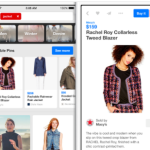Content Publishers Underestimate the “Shoppable Content” Challenge
One question I’ve heard content publishers ask lately is, what if you could purchase something you see in an article, on a social media platform without having to click through to a separate site? Here’s an example: instead of going to Amazon to see if you can find that lipstick shade you read about in a magazine, you can buy that lipstick simply by clicking on the image of the lipstick within the article. This is “shoppable content,” and those in the content provision business, like publishers and media platform owners, think it could be a major new revenue opportunity.
Pinterest is one example. Almost a year ago, social networking platform Pinterest launched a new service where users could purchase products without having to leave the platform for an external ecommerce site. Called “buyable pins,” this service makes items in over 60 million pins available  for purchase, showing they are available by having the price included in blue.
for purchase, showing they are available by having the price included in blue.
The pins are currently integrate able with five vendor platforms: BigCommerce, Demandware, Magento, IBM Websphere, and Shopify. If you are on a home-grown or platform from another vendor, you are out of luck at the moment, but you can sign up to be on Pinterest’s waitlist.
Another example: Snapchat and Hearst recently announced plans to offer shopping opportunities on Sweet, their joint Snapchat channel. The potential for integrating transactions into the Snapchat platform, as with Pinterest (with its 100 million monthly users), is immense: Snapchat currently has about 100 million daily active users, and recently reported that video consumption on the mobile-only platform had hit 7 billion videos per day.
In short, a tremendous amount of rich content is getting in front of a massive number of eyeballs. No wonder brands and advertisers are salivating over the prospect of enabling this content with e-commerce.
However, therein lies a problem about which I have heard e-commerce professionals express frustration about: that the front-end content experts build content first, thinking that the commerce piece can be “added on” at a later date. Indeed, the Recode article announcing the Sweet channel launch on Snapchat noted that:
Speaking broadly of how Hearst-owned Cosmopolitan will generate more revenue online, Coles said, “clearly [through] e-commerce but I don’t think necessarily the tech bit is quite there, quite yet for how we would like to do it.”
Coles is Joanna Coles, the editor-in-chief of Cosmopolitan and a Snapchat board member. The same article also quoted Coles as saying that “At some point [Sweet] will morph into an e-commerce platform so that you will be able to buy from it.”
Huh? How does a content platform “morph” into a transactional one? That sentence illustrates the content and commerce divide that I’ve written about, where the folks in the content world (in these cases, management at Hearst and Pinterest) underestimate the degree of back-end processes and technology expertise needed to integrate content with commerce.
What about Pinterest’s buyable pins – how have they been working out? Given that neither Pinterest nor its partner e-commerce vendors have provided any data nearly a year after announcing their availability, adoption has probably been slow. One reason may be that they are currently only available on Android and iOS, while most e-commerce transactions still tend to happen on desktop devices (at least in the U.S.). Pinterest has said it plans to roll out web-based pins soon, as well as admitting that it still early days for the pins. Now that the platform is built, it wants to understand how to better connect people ready to buy with the right products.
I still think there is a whole piece these content publishers are missing: that e-commerce is not just a shopping cart where you tack on a bunch of credit cards. The front end is just the beginning. A major part of providing a great purchasing experience is on the back end: that what they are interested in is in stock, that they can use the payment method of their choice, that they can get it delivered promptly, and that they can return it if they want at no additional cost. Successful online retailers have made sure to invest in and optimize these parts of the customer experience, and emphasize them in their marketing and messaging.
My prediction is that the first content publisher to see significant success in shoppable content will be the one that involves a senior e-commerce executive to the project plans at inception, rather than after rolling out the initial platform then looking how to “morph” into a commerce platform. In the meantime, expect more content executives to publicly extol the potential for shoppable commerce on their platforms with little concrete plans or data to show it can work.








